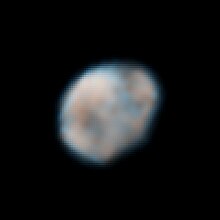Rheasilvia




Rheasilvia /ˌriːəˈsɪlviə/ is the most prominent surface feature on asteroid 4 Vesta and is believed to be an impact crater. 505 kilometres (314 mi)* in diameter, it is 95% the diameter of the asteroid, making it one of the largest craters in the Solar System, and covers most of the southern hemisphere. It partially obscures an earlier crater, named Veneneia, that at 395 kilometres (245 miles) is almost as large.[1] It was discovered in Hubble images in 1997,[2] but was not named until the arrival of the Dawn spacecraft in 2011. It is named after Rhea Silvia, a mythological vestal virgin and mother of the founders of Rome.[3]
Rheasilvia has an escarpment along part of its perimeter which rises 4–12 km above the surrounding terrain. The crater floor lies about 13 kilometres (8.1 mi)* below the surrounding surface. This basin consists of undulating terrain and a central mound, almost 200 kilometres (120 mi)* in diameter, which rises 23 kilometres (14 mi)* from its base, the tallest mountain known in the Solar System. Spectroscopic analyses of Hubble images have shown that this crater has penetrated deep through several distinct layers of the crust, and possibly into the mantle, as indicated by spectral signatures of olivine.[4]
Vesta has a series of grooves in an equatorial region running parallel to the rim of Rheasilvia. These are believed to be compression fractures from the impact. There is expected to be impact-related topography at the antipodes as well, but this will not be known until the north pole becomes visible at the end of the northern winter.
It is estimated that the impact responsible excavated about 1% of the volume of Vesta, and it is likely that the Vesta family and V-type asteroids are the products of this collision. If this is the case, then the fact that 10-km fragments have survived bombardment until the present indicates that the crater is at most about 1 billion years old.[5] It would also be the origin of the HED meteorites. Known V-type asteroids account for 6% of the ejected volume, with the rest of the fragments presumably either too small to observe, or removed from the asteroid belt by approaching the 3:1 Kirkwood gap, by the Yarkovsky effect, or (in the case of small fragments) by radiation pressure.
References
- ^ 'Vesta seems more planet than asteroid', Science News, 2012 Mar 22
- ^ Hubble Reveals Huge Crater on the Surface of the Asteroid Vesta
- ^ a b "Rheasilvia". Gazetteer of Planetary Nomenclature. USGS Astrogeology Research Program.
- ^ Thomas, P. C.; et al. (1997). "Vesta: Spin Pole, Size, and Shape from HST Images". Icarus. 128 (1): 88. Bibcode:1997Icar..128...88T. doi:10.1006/icar.1997.5736.
{{cite journal}}: Explicit use of et al. in:|author=(help) - ^ Binzel, R. P. (1997). "Geologic Mapping of Vesta from 1994 Hubble Space Telescope Images". Icarus. 128 (1): 95. Bibcode:1997Icar..128...95B. doi:10.1006/icar.1997.5734.
{{cite journal}}: Unknown parameter|coauthors=ignored (|author=suggested) (help)
